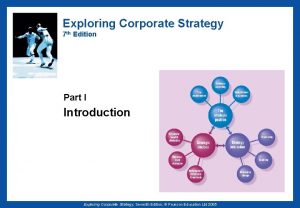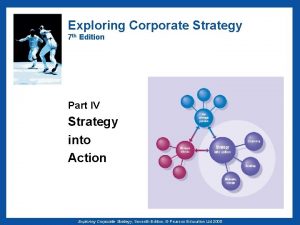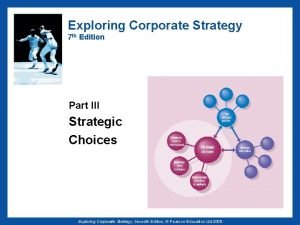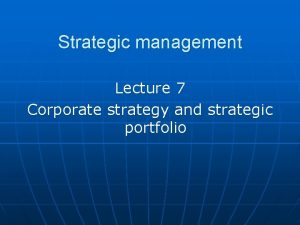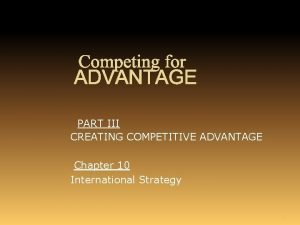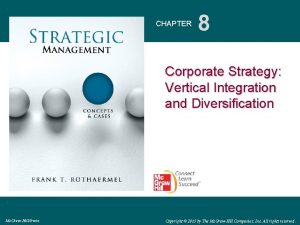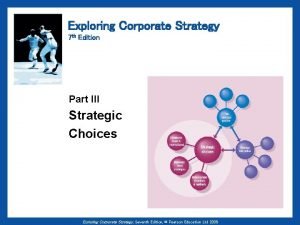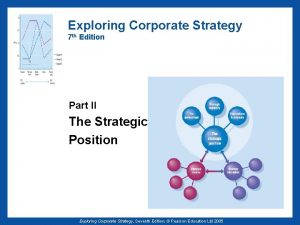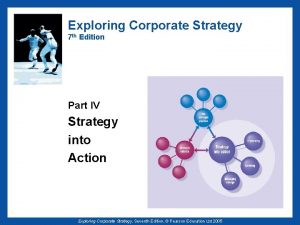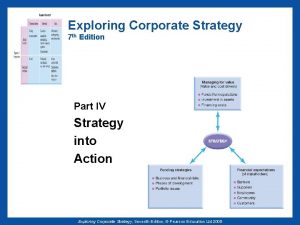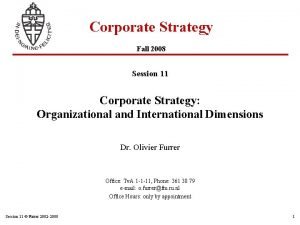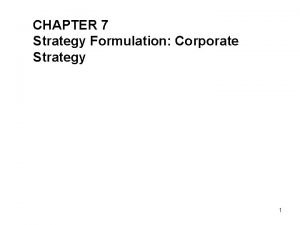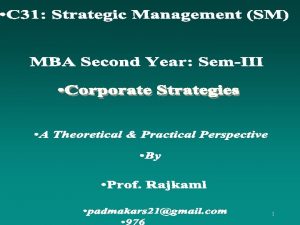Exploring Corporate Strategy 7 th Edition Part III
































- Slides: 32

Exploring Corporate Strategy 7 th Edition Part III Strategic Choices Exploring Corporate Strategy, Seventh Edition, © Pearson Education Ltd 2005

Strategic Choices Exhibit III. 1 Exploring Corporate Strategy, Seventh Edition, © Pearson Education Ltd 2005

Exploring Corporate Strategy 7 th Edition Chapter 5 Business Level Strategy Exploring Corporate Strategy, Seventh Edition, © Pearson Education Ltd 2005

Business Level Strategy - Outline • Strategic business units • Competitive advantage (strategy clock) – Price-based – Differentiation – Hybrid and focus • Sustainability of competitive advantage • Co-operation and competition • Game theory in competitive strategy Exploring Corporate Strategy, Seventh Edition, © Pearson Education Ltd 2005

Business Level Strategies Exhibit 5. 1 Exploring Corporate Strategy, Seventh Edition, © Pearson Education Ltd 2005

Strategic Business Units A strategic business unit is a part of an organisation for which there is a distinct external market for goods or services that is different from another SBU • Opposing pitfalls in identifying SBUs – Too many different products/markets means lack of focus – Too few means not reflecting diversity of products/markets Exploring Corporate Strategy, Seventh Edition, © Pearson Education Ltd 2005

Criteria for Identifying SBUs External Internal Same customer types Similar products/services Same channels Similar technologies Similar competitors Similar resources and competences Exploring Corporate Strategy, Seventh Edition, © Pearson Education Ltd 2005

Bases of Competitive Advantage • Competitive strategy – The bases for achieving competitive advantage – The bases for providing best value • Porter’s generic strategies – Cost leadership – Differentiation – Focus • Bowman and D’Aveni’s market facing strategies – Provide customer needs better or more effectively than competitors – The strategy clock Exploring Corporate Strategy, Seventh Edition, © Pearson Education Ltd 2005

The Strategy Clock Note: The strategy clock is adapted from the work of Cliff Bowman (see D. Faulkner and C. Bowman, The Essence of Competitive Strategy, Prentice Hall, 1995. ) However, Bowman uses the dimenstion ‘Perceived Use Value’. Exhibit 5. 2 a Exploring Corporate Strategy, Seventh Edition, © Pearson Education Ltd 2005

The Strategy Clock Exhibit 5. 2 b Exploring Corporate Strategy, Seventh Edition, © Pearson Education Ltd 2005

“No Frills” Strategy Low price Low perceived product/service benefits Focus on price-sensitive market segment • Commodity-like products or services • Price-sensitive customers • High buyer power and/ or low switching costs • Small number of providers with similar market shares • Avoiding the major competitors Exploring Corporate Strategy, Seventh Edition, © Pearson Education Ltd 2005

Low Price Strategy Lower price than competitors Maintain similar product/service benefits Public sector – year on year efficiency gains • Pitfalls of low price strategy – Margin reduction (competitor reaction) – Inability to reinvest leading to loss of perceived benefit of product • Need a low cost base – Low cost itself not a basis for advantage – Low cost achieved in ways that competitors cannot match to give sustainable advantage Exploring Corporate Strategy, Seventh Edition, © Pearson Education Ltd 2005

Differentiation Strategies Offering benefits different from competitors Widely valued by buyers Better products/services at same or higher price Public sector - centre of excellence • Success depends on – Identification of strategic customers and knowing what they value – Knowing the competitors • Narrow competitor base – focused differentiation • Wide competitor base – address bases of differentiation valued by customers Exploring Corporate Strategy, Seventh Edition, © Pearson Education Ltd 2005

Hybrid Strategy Simultaneously achieving differentiation and a price lower than competitors • Achieve greater volumes • Clarity about activities on which differentiation can be built (core competences) • Reduce costs on other activities • Entry strategy in market with established competitors Exploring Corporate Strategy, Seventh Edition, © Pearson Education Ltd 2005

Focused Differentiation High perceived product/service benefits to selected market segment (niche) Premium products, heavily branded • Choice to be made between focused differentiation and broad differentiation if growth required • Difficult when the focus strategy is only part of an organisation’s overall strategy • Possible conflict with stakeholder expectations • New ventures start off focused, but need to grow • Market situation may change, reducing differences between segments Exploring Corporate Strategy, Seventh Edition, © Pearson Education Ltd 2005

Failure Strategies Do not provide perceived value-for-money in terms of product features, price or both • Increase price without increasing product/service benefit • Reduce benefits whilst maintaining price Exploring Corporate Strategy, Seventh Edition, © Pearson Education Ltd 2005

Sustaining Competitive Advantage Exhibit 5. 3 Exploring Corporate Strategy, Seventh Edition, © Pearson Education Ltd 2005

Competitive Strategies in Hypercompetitive Conditions • Competitive advantage is temporary – Rapid imitation – Not sustainable • Competitive advantage relates to – Organisation’s ability to change – Speed – Flexibility – Innovation – Disruption of market Exploring Corporate Strategy, Seventh Edition, © Pearson Education Ltd 2005

Competitive Strategies in Hypercompetitive Conditions Exhibit 5. 4 Exploring Corporate Strategy, Seventh Edition, © Pearson Education Ltd 2005

Competition and Collaboration • Collaboration may help to achieve advantage or avoid competition • Organisations may compete in some markets and collaborate in others • Collaboration can be – between potential competitors or – between buyers and sellers • Collaboration is advantageous when the transaction costs are lower than when operating alone • Collaboration can help build switching costs Exploring Corporate Strategy, Seventh Edition, © Pearson Education Ltd 2005

Competition and Collaboration Exhibit 5. 5 Exploring Corporate Strategy, Seventh Edition, © Pearson Education Ltd 2005

Game Theory The inter-relationships between the competitive moves of a set of competitors • Strategist must anticipate competitor reactions • Core assumptions: – Competitor will behave rationally and try to win – Competitor is in an interdependent relationship with other competitors – Competitors are aware of the interdependencies and of the moves that competitors could take Exploring Corporate Strategy, Seventh Edition, © Pearson Education Ltd 2005

Implications of Game Theory • To benefit from game theory strategists need to: – Put themselves in the position of the competitors • Take an informed, rational view on likely competitor actions • Choose best course of action – Identify if there is any competitor strategy which might lead to their domination of the market • Take steps to eliminate the strategy Exploring Corporate Strategy, Seventh Edition, © Pearson Education Ltd 2005

A Prisoner’s Dilemma Exhibit 5. 6 Exploring Corporate Strategy, Seventh Edition, © Pearson Education Ltd 2005

Principles of Prisoner’s Dilemma • A dominant strategy – Outperforms all other strategies whatever rivals choose – May be a lesser pay-off than could logically be achieved • A dominated strategy – A competitive strategy pursued by a competitor, which outperforms the company whatever it chooses • Equilibrium – Each competitor gets the best possible strategic solution given the response from the other Exploring Corporate Strategy, Seventh Edition, © Pearson Education Ltd 2005

A Simultaneous Move Game Source: Adapted from A. Dixit and B. Nalebuff, Thinking Strategically, W. W. Norton, 1991. Exhibit 5. 7 Exploring Corporate Strategy, Seventh Edition, © Pearson Education Ltd 2005

A Sequential Move Game Source: Adapted from A. Dixit and B. Nalebuff, Thinking Strategically, W. W. Norton, 1991. Exhibit 5. 8 Exploring Corporate Strategy, Seventh Edition, © Pearson Education Ltd 2005

Lessons from Game Theory • • • Bluff and counterbluff Identify dominant and dominated strategies Importance of timing of strategic moves Need to weigh up risks Establish credibility and commitment Exploring Corporate Strategy, Seventh Edition, © Pearson Education Ltd 2005

Repeated Games • Repeated interaction leads to greater cooperation or accommodation of interests • Learn through experience • Cooperation depends on the following: – Number of competitors in market – Small competitors may gain disproportionately, but larger competitors may tolerate this – Substantial differences between organisations makes cooperation less likely – Lack of transparency on bases of competition makes cooperation less likely Exploring Corporate Strategy, Seventh Edition, © Pearson Education Ltd 2005

Changing Rules of the Game • The logic of the game may mean that it is impossible to compete within existing rules • Alternative approach: Change the rules of the game • In price-based market – Shift bases of differentiation – Make pricing more transparent – Incentives for customer loyalty Exploring Corporate Strategy, Seventh Edition, © Pearson Education Ltd 2005

Key Points (1) • Business level strategy – Competing better/providing best value – Strategy development for each SBU • Generic strategies for competitive advantage – No frills, low price, differentiation, hybrid, focused differentiation • Sustainable competitive advantage requires – Linked competences, difficult to imitate – Ability to achieve lock-in as industry standard Exploring Corporate Strategy, Seventh Edition, © Pearson Education Ltd 2005

Key Points (2) • Hypercompetition – Need speed, flexibility, innovation and change • Collaboration and competition – As alternatives or in parallel • Game theory – Pre-empt or counter competitors’ moves Exploring Corporate Strategy, Seventh Edition, © Pearson Education Ltd 2005
 Exploring corporate strategy 7th edition
Exploring corporate strategy 7th edition Exploring corporate strategy 7th edition
Exploring corporate strategy 7th edition Exploring corporate strategy 7th edition
Exploring corporate strategy 7th edition Business strategy vs corporate strategy
Business strategy vs corporate strategy Concentric growth strategy
Concentric growth strategy Hamlet act iii scene ii
Hamlet act iii scene ii Exploring strategy model
Exploring strategy model Corporate finance and corporate governance
Corporate finance and corporate governance Fundamentals of corporate finance, third canadian edition
Fundamentals of corporate finance, third canadian edition Corporate finance tenth edition
Corporate finance tenth edition Fundamentals of corporate finance third canadian edition
Fundamentals of corporate finance third canadian edition Fundamentals of corporate finance fifth edition
Fundamentals of corporate finance fifth edition Fundamentals of corporate finance 6th edition
Fundamentals of corporate finance 6th edition Corporate finance tenth edition
Corporate finance tenth edition Corporate finance tenth edition
Corporate finance tenth edition Corporate finance tenth edition
Corporate finance tenth edition Corporate finance tenth edition
Corporate finance tenth edition Mis chapter 6
Mis chapter 6 Zulily case study
Zulily case study Va professional standards board
Va professional standards board Types of organisational strategies
Types of organisational strategies What is corporate strategy in strategic management
What is corporate strategy in strategic management Business vs corporate strategy
Business vs corporate strategy Corporate scope
Corporate scope Strategy map hr scorecard digital dashboard
Strategy map hr scorecard digital dashboard Diversification horizontal
Diversification horizontal Corporate strategy of tata motors
Corporate strategy of tata motors Corporate strategy triangle
Corporate strategy triangle A multidomestic corporate-level strategy is one in which:
A multidomestic corporate-level strategy is one in which: Corporate level cooperative strategy
Corporate level cooperative strategy Corporate level cooperative strategy
Corporate level cooperative strategy Corporate strategy
Corporate strategy Make or buy continuum
Make or buy continuum
